Important Chinese imperial spinach-green jade 'Shui Mu Zhan Qing Hua' seal, Jiaqing to be sold at Bonhams
The exceptional seal is recorded in the Imperial archives, published by the Palace Museum, Beijing. Photo: Bonhams.
HONG KONG.- The Imperial seal belonging to the fifth Emperor in the Qing dynasty, Jiaqing, will be offered in the Fine Chinese Ceramics and Works of Art sale, at Bonhams Hong Kong on 4 June. It is estimated at HKD 2,000,000 – 3,000,000.
It belonged to a set of three Imperial seals, with the other two bearing the inscriptions Qinghuige and Yun ri xiang hui ying. The exceptional seal is recorded in the Imperial archives, published by the Palace Museum, Beijing.
Inscribed 'shui mu zhan qing hua' (「水木湛清華」), which translates as ‘Tranquil water and luxuriant trees in the garden', the seal was made specifically to be stored in the Qinghuige, a special Imperial retreat, set in the western part of the Jiuzhouqingyan, a tranquil and scenic island within the celebrated Imperial palaces and gardens complex - the Yuanmingyuan.
Qinghuige, extremely private and secluded, was reserved solely for the use of the Emperor and members of the Imperial family, with special entry permits required for officials and servants.
The Qinghuige, became a favourite location with the Qianlong Emperor (reign 1736-1795), who commissioned paintings of himself within the complex; and with his son, the Jiaqing Emperor who wrote poems and made observations on his time spent there, allowing him precious moments of tranquillity amidst the serene landscape, whilst reflecting on his lifelong duty towards his people.
The Qinghuige was demolished during the early Daoguang reign period (1821-1850), therefore making this important seal, an exceptionally rare surviving Imperial artefact documenting the existence and beauty of the Qinghuige, a personal space of tranquillity cherished by the emperors.
Asaph Hyman, Director of Chinese Art commented: “This Imperial jade seal, safeguarded for many years in an English private collection, is exceptionally rare and of historical, cultural and aesthetic importance.”
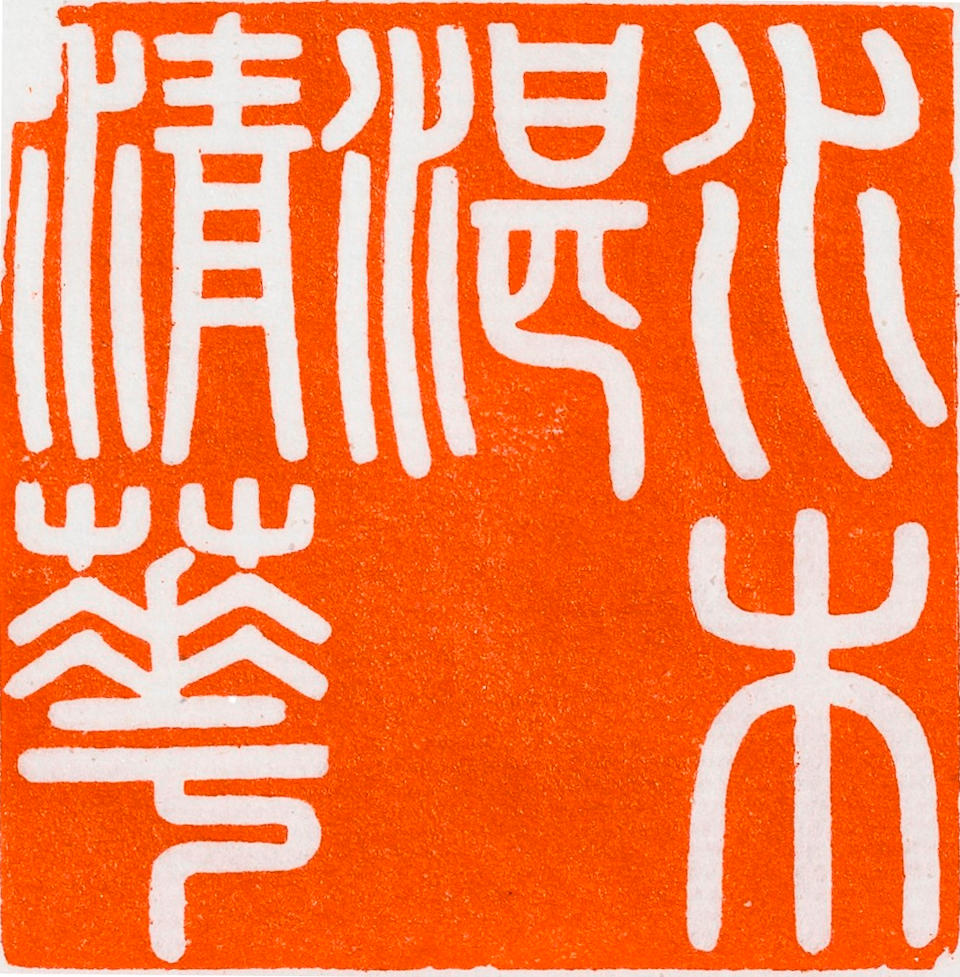
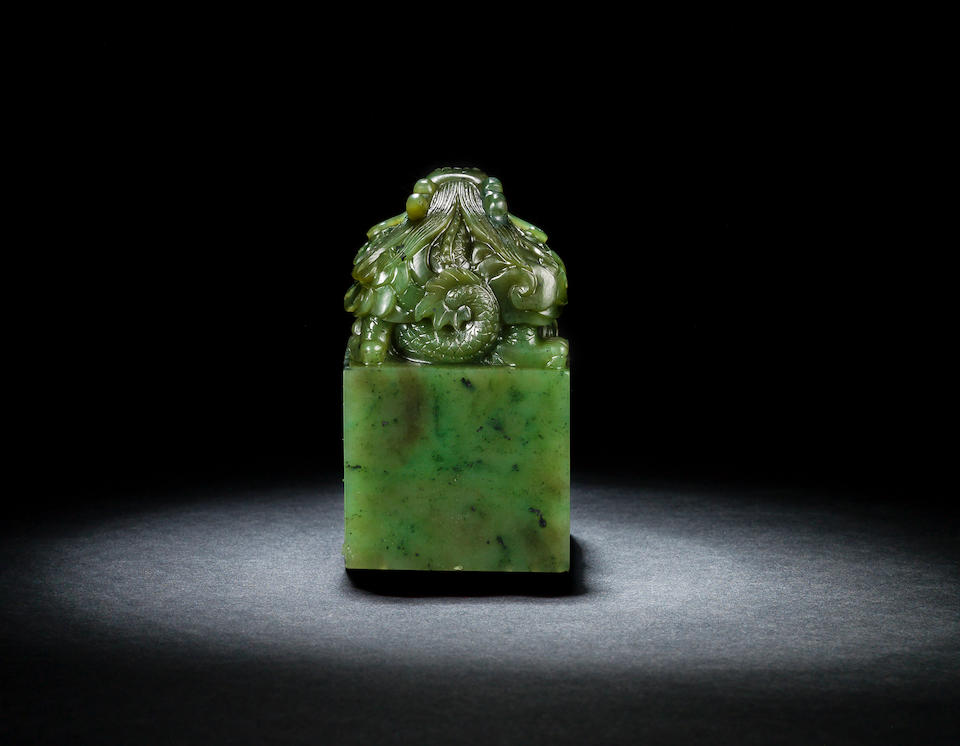
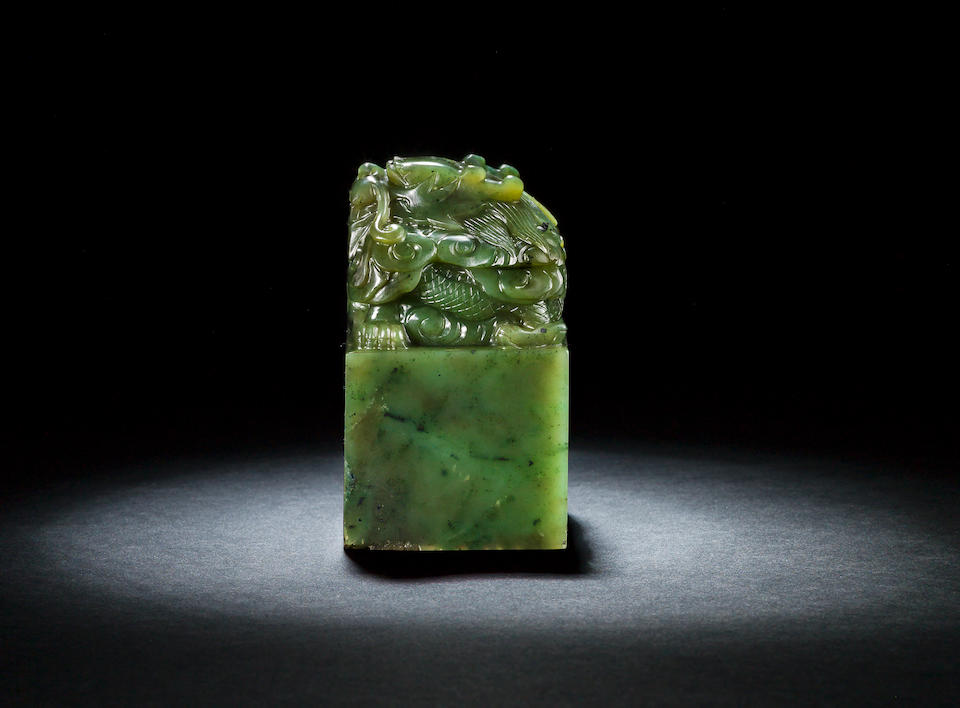
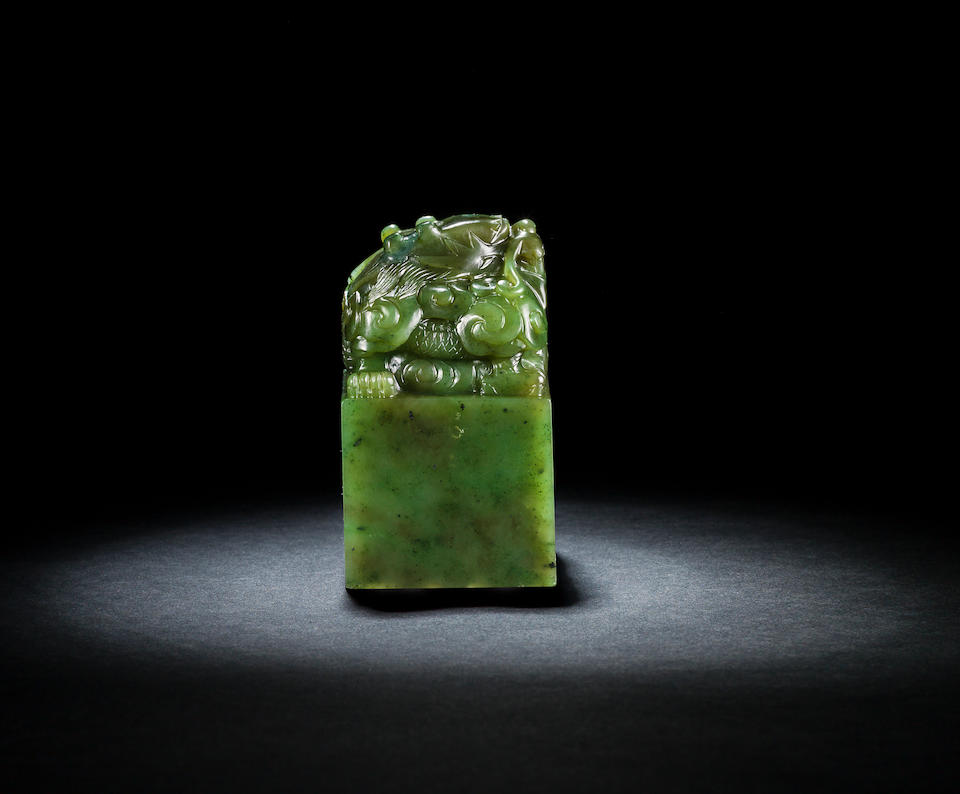
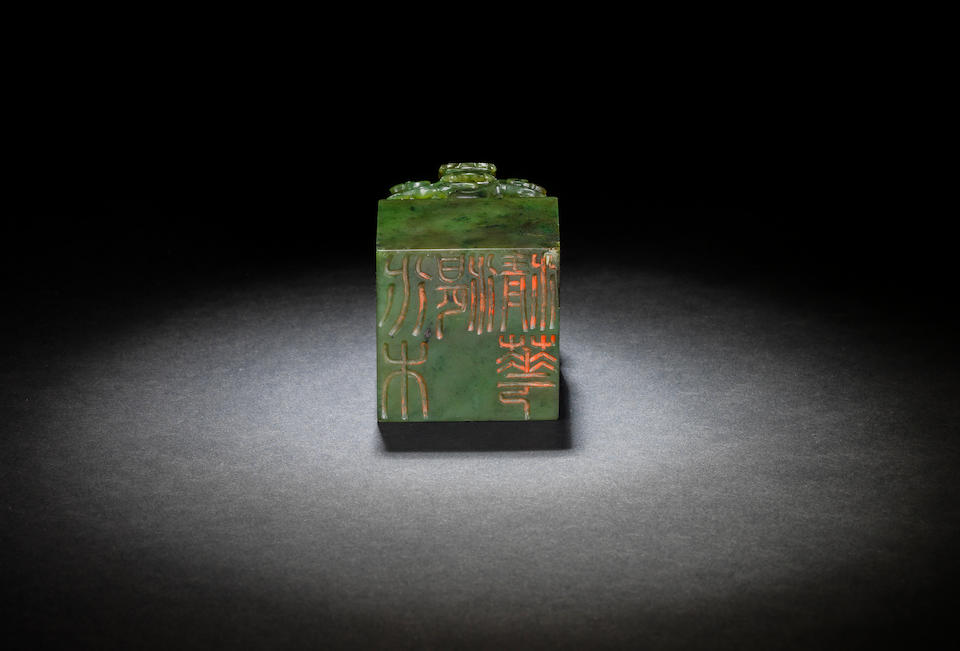
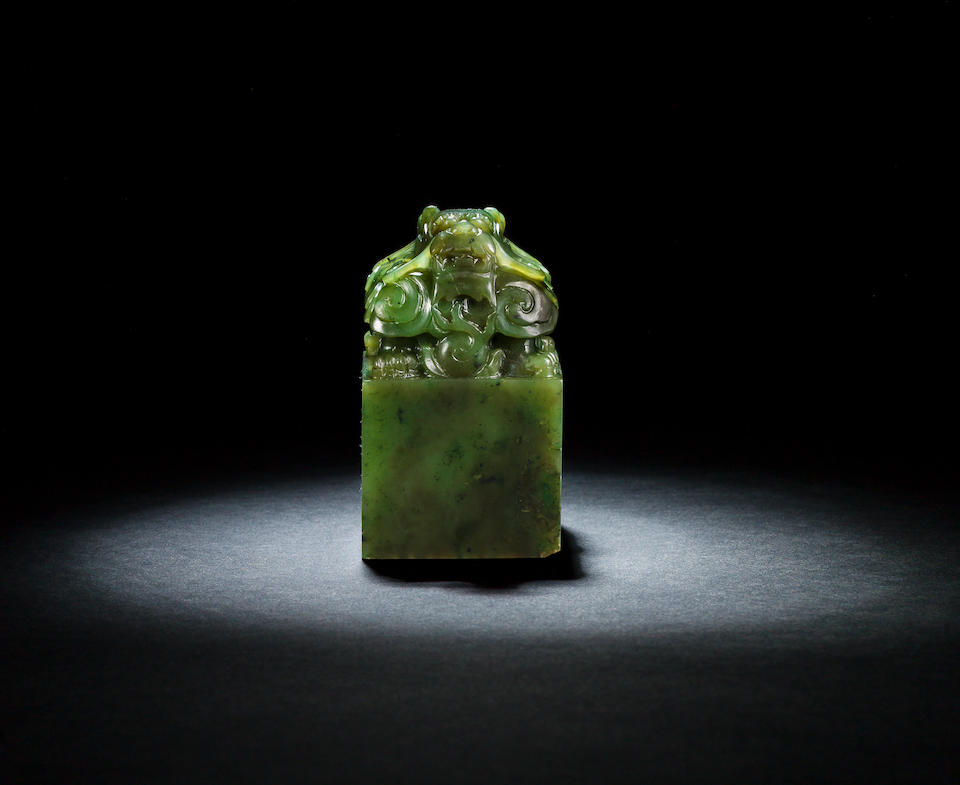

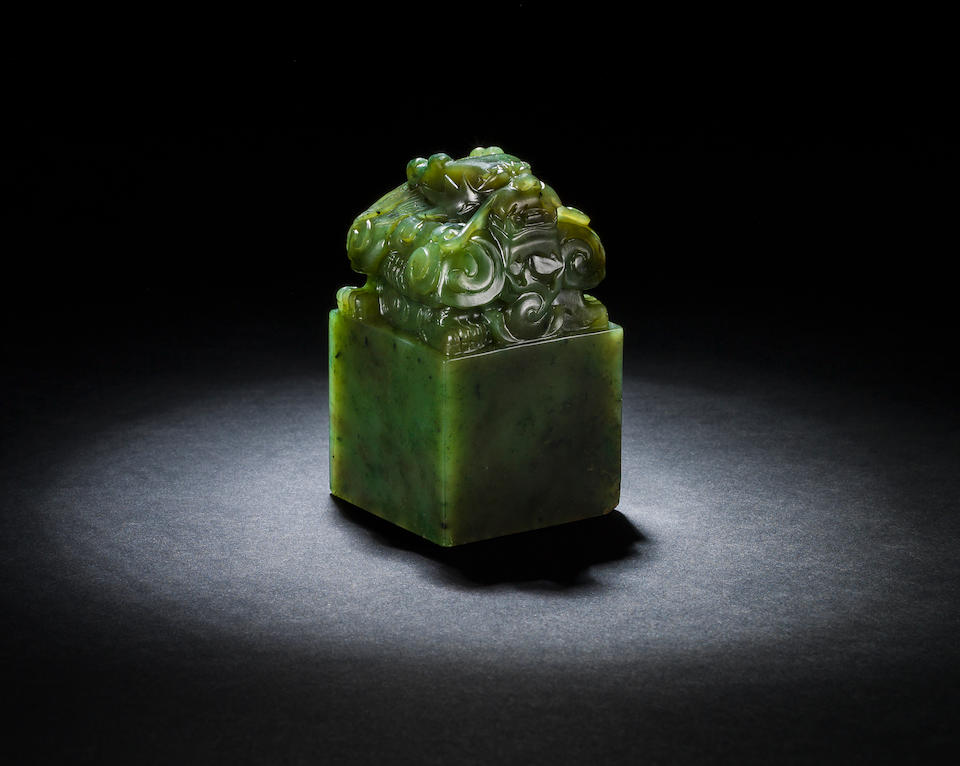
Lot 57. An important imperial spinach-green jade 'shui mu zhan qing hua' seal, Jiaqing period (1796-1820); 7.3cm high x 4.2cm square (2 7/8in high x 1 5/8 in square). Estimate HK$ 2 million - 3 million (€230,000 - 340,000). Sold for HK$ 2,440,000 (€ 290,116). Photo: Bonhams.
The square base surmounted by a lively five-clawed dragon, crouching on his four legs amidst cloud scrolls, with each clawed foot turned the other way, together forming the character wan, the flaming pearl of wisdom set below the dragon's open jaws revealing his tongue and flanked by the elongated whiskers, below the ruyi-shaped nose, bulging eyes and bushy eyebrows flanked by the two horns, the flowing mane parted along the scaled body with a knobbed spine, terminating in coiled and spiked tail, the underside finely incised in zhuanshu script with five characters reading 水木湛清華 shui mu zhan qing hua, which may be read as: 'Tranquil water and luxuriant trees in the garden', the jade stone of a vibrant green tone highlighted by speckled black flecks.
Provenance: An English private collection
According to the family, the seal was gifted to the late father of the present owner prior to 1994
Note: The important and rare spinach green jade 'shui mu zhan qing hua' seal belongs to a set of three imperial jade seals, with the other two bearing the inscriptions 清暉閣 Qinghuige and 雲日相暉映 yun ri xiang hui ying. This set of seals is recorded in The Palace Museum, 清代帝后璽印譜Qingdai dihou xiyin pu [Catalogue of Imperial Seals of the Qing Dynasty], vol.9, Jiaqing section 2, Beijing, 2005, p.150.
This set of seals was used for and within the Qinghuige, a summer retreat located in the western part of the 九州清晏Jiuzhouqingyan, a tranquil and scenic island within the Yuanmingyuan.
First constructed during the Kangxi period, the Qinghuige was purposefully built as part of the imperial family's living and leisure quarters. It was also the designated place for the celebration of the Lantern Festival during the Yongzheng and Qianlong periods. Extremely private and secluded, this highly secured area was reserved solely for the use of the emperor and members of the imperial family. Special permits were required for officials and servants to enter; see He Yan, '再現圓明園-九洲清晏(下)Zaixian Yuanmingyuan-Jiuzhouqingyan (Third)',《紫禁城》Zijincheng, Beijing, Jan 2012, pp.26 and 37.
Similarly to the Sanxitang ('Hall of Three Rarities'), the Qinghuige was another imperial space of personal importance to the Qianlong emperor. He enjoyed playing musical instruments and performing tea ceremonies there. His clear affection for the retreat is evident in the emperor's special commissioning of several imperial paintings recording the scenery of the summer retreat in the Palace Museum, Beijing, illustrated by by Liao Baoxiu, 茶韻茗事-故宮茶話 Chayun mingshi-Gugong chahua, Taipei, 2010, pp.156 and 159. These include:
Two paintings by Zhang Zongcang 張宗蒼, the first titled 弘曆松蔭揮筆圖Hongli songyin huibi tu [Hongli writing under pine trees]and the second titled 弦曆撫琴圖 Hongli fuqian tu [Hongli Playing Qin], both cyclically dated to 癸酉 guiyou, corresponding to 1753;
A painting by Dong Bangda 董邦達, titled 弘曆松蔭消夏圖(山靜日長圖) Hongli songyin xiaoxia tu (shan jing ri zhang tu) [Hongli spending summer under pine trees], cyclically dated to 甲子 jiazi, corresponding to 1744.
Following in his father's footsteps, the Qinghuige continued to be a preferred favourite of the Jiaqing emperor. The emperor recorded his personal fondness and affection for the pavilion in an imperial poem, cyclically dated to 甲子 jiazi, corresponding to 1804, titled 《清暉閣晚坐吟》 Qinghuige wanzuo yin ('Recitation While Sitting in the Night at the Qinghuige'); see 清仁宗御制詩 Qing Renzong Imperial Poetry, vol.3, Haikou, 2000, p.19.
The first seven verses may be translated as follows:
'Unsurpassed Imperial garden for retreat during the hot summer
Dense pine trees overshadowing the blazing sunlight
Grand and tall where the air is fresh
Gusts of light breeze flow through the long corridors
In good spirits with heart at peace,
Visiting occasionally to recite at this artistic haven
A place where one would find contentment'
A further recording of his time spent in the retreat whilst reading the first two chapters of a book on politics titled 《資治通鑑》 zizhi tongjian, provides us with a priceless and intimate insight into the emperor's state of mind and the importance of the Qinghuige to him. The record begins with a description of the pavilion and his fondness for it, and is followed by his thoughts on governance, noting his insights on qualities a leader should have. This record, cyclically dated wuchen zhongfu ri, 戌辰中伏日, corresponding to 28 July 1808, is included in the imperial manuscript 《清暉閣觀書記》 Qinghuige guanshu ji [Reading at Qinghuige], published in 秘殿珠林石渠寶笈三編 Midian zhulin shiqu baoji sanbian, vol.8, Taipei, 1969, pp.3636-3637.
The first seven verses may be translated as follows:
'Qinghuige, west of the sleeping chambers
Standing grand and tall, both air and incense flows
Far reaching views through many layers
Sitting quietly for a few moments
Viewing the serene landscapes, anxiety dissipates
Entering a tranquil realm
Mind and body become one'
The eloquent prose and the evocative record of the Jiaqing emperor's thoughts reflect the lifelong relentless duty he felt towards his people, that laid heavily on the shoulders, and his continuous perseverance to improve his rule. It also demonstrates the importance of the retreat as one of few places where he could take a pause, 'sit quietly for a few moments' and enter a spiritual place of tranquillity, though even in those few treasured moments the emperor's mind was not far from his duty
The phrase 水木湛清華 shui mu zhan qing hua, inscribed on the present jade seal, which may be translated as 'Tranquil water and luxuriant trees in the garden', are an allusion to the landscape scenery of the Qinghuige. The phrase originates in an Eastern Jin dynasty poem by Xie hun, entitled, 遊西池詩 You xichi shi. The poem addresses the temporality of life through describing the surrounding scenery:
悟彼蟋蟀唱,信此勞者歌。
有來豈不疾,良遊常蹉跎。
逍遙越城肆,願言屢經過。
迴阡被陵闕,高台眺飛霞。
惠風盪繁囿,白雲屯曾阿。
景昃鳴禽集,水木湛清華。
褰裳順蘭沚,徙倚引芳柯。
美人愆歲月,遲暮獨如何?
無為牽所思,南榮戒其多。
The Qinghuige was demolished during the early Daoguang period and the area was reconstructed into new pavilions. It is therefore likely that the seal would have been removed for safe keeping, probably within the Forbidden City.
A unique work of art, the present seal is one of the few surviving imperial artefacts that documents the existence and beauty of the Qinghuige, a personal space of tranquillity for the Qianlong and Jiaqing emperors.
The continuation of artistic styles and decorative designs on imperial artefacts from the Qianlong period, such as the present lot, expresses the Jiaqing emperor's reverence and filial duty to his father's reign. This direct visual continuation from the former to the latter reign is demonstrated in seals of similar form and design dated to the Qianlong reign period: see from the Qing Court Collection, an imperial green jade 'Xin qing wen miao xiang' seal, Qianlong (6.7cm high), illustrated in Classics of the Forbidden City: Imperial Seals of the Ming and Qing Dynasties, Beijing, 2008, pl.193; for another imperial greyish-green seal, Qing dynasty, of similar design of crouching dragon with its feet pointing in different directions, inscribed 'Chizheng wanmin zhi bao' (12.6cm long x 10.4cm high), see The Complete Collection of Treasures of the Palace Museum: Ancient Seals, Shanghai, 2008, pl.394. Compare also, from the British Museum, an imperial grey jade 'zi qian bu xi' seal, 18th century (5.7cm wide x 8.8cm high; museum ref.no.1885,1227.65), which entered the museum's collection in 1885. Sets of three imperial seals were particularly favoured during the late Qianlong period, especially for his 80th birthday, with this style of grouping continuing onto the Jiaqing period.
Compare a related imperial spinach green jade 'hui qi you ji' seal, Jiaqing, (7cm high), sold at Sotheby's Hong Kong on 5 October 2011, lot 1910.
An imperial spinach jade 'Hui Qi You Ji' seal, Qing dynasty, Jiaqing period. Lot sold 8,420,000 HKD at Sotheby's Hong Kong on 5 October 2011. Photo: Sotheby's
the plain high square base surmounted by a carved and pierced top in the form of a ferocious dragon in pursuit of a 'flaming pearl', its undulating body with finely incised scales meandering within dense cloud scrolls to display great vigour and power, its head carved with bulging eyes and flared nostrils above its clenched open mouth revealing a curled tongue between sharp fangs, the seal face deeply and crisply carved with the four characters Hui qi you ji ('Maintain one's standards'), a phrase excerpted from Shangshu ('The Book of History'), the stone of a dark green tone with areas of darker speckling - 7 cm., 2 3/4 in.
The Jiaqing Hui Qi You Ji Seal
Guo Fuxiang
Researcher, The Palace Museum, Department of Palace History, Beijing
Sotheby's Hong Kong has recently acquired a seal of the Jiaqing emperor (r. 1796–1820) that will be sold at auction. This imperial seal has a body of green jade and a knob of a dragon in the clouds. Its base is 5.4 centimeters square and it has a four-character inscription: Hui qi you ji ('Maintain one's standards'). The carving of both the knob and the inscription are fine, skillful and well executed—an indication of the carver's superior artistry. There is a clear record of this seal in the Jiaqing bao sou (Collection of Jiaqing Seals), presently held by the Beijing Palace Museum. A comparison of the seal with the description shows that this seal matches the description in material of composition, size, and style and layout of the seal characters. We can thus affirm that this seal is the authentic Jiaqing imperial seal described in the catalogue. According to the Jiaqing bao sou, this seal was one of a set of three, the other two seals being Xianfu Gong ('Xianfu Palace') and Xu yi shou ren ('Encounter others with an open mind'). This shows that these three seals were made with the intention of placing them in the Xianfu Palace.
The owner of this seal, the Jiaqing emperor named Yong Yan, was the fifth Qing emperor after the Qing conquered China. His twenty-five-year reign followed the prosperity of the early Qing dynasty, yet served as an important turning point toward China's later decline. Hence, circumstances in many areas of Chinese life present a complicated picture. Among the emperors of the Qing dynasty, the Jiaqing emperor had relatively many seals. And like the age in which he lived, his seals were a mixture of zenith and decline. As is well known, the Jiaqing emperor was 36 when he ascended the throne, but unlike other emperors, after he ascended the throne, he could not exercise authority, since the Qianlong emperor emeritus still retained the final authority to make decisions. These peculiar circumstances made it difficult for the Jiaqing emperor to break away from traditions established during the reign of the Qianlong emperor. All aspects of the Qianlong period (1736–1795) were carried forward into the Jiaqing period. This inertia also found faithful expression in the seals made by the Jiaqing emperor. One example is the seal sets made by this emperor. During his reign, the Qianlong emperor made a considerable number of seal sets consisting of one seal for the front of a work and two seals for the back of a work. Such seal sets can be divided into two types. One type of seal set consists of a front seal with the name of a palace building and of two back seals with a memorable or suggestive phrase giving the significance and origin of the building name on the front seal. This type of set can be called a palace-building seal set. In the other type of seal set, the front seal and both back seals feature fixed phrases that elaborate on each other. This type of set can be called a fixed-phrase seal set. Like the Qianlong emperor before him, the Jiaqing emperor made more than seventy sets of seals.1 And the set to which the seal Hui qi you ji belongs is of the former type of set. In the making of seals, the Jiaqing emperor thus seems to be following in the tracks of the Qianlong emperor by imitating him. He was unfortunately led to do this by his special social and familial circumstances, mentioned above.
If, as stated above, the Jiaqing emperor imitated the Qianlong emperor in the making of seals in a way that reflects how the Jiaqing court continued Qianlong traditions, then an explanation of the meaning of this seal can tell us something about the Jiaqing emperor's own thoughts and perceptions as China transitioned from prosperity to decline. As I already mentioned, the Hui qi you ji seal is one part of a palace-building seal set of three, and such sets of seals have inscriptions that are intimately related. The inscriptions of the two back seals express the seal owner's understanding and gives explanation to the palace-building name. Hence I think that to understand any one of the seals of a set, it is necessary to explain all three seals as a group. Accordingly, to understand the seal Hui qi you ji, we have to consider it together with the Xianfu gong seal and the seal Xu yi shou ren in the context of the historical circumstances of the Jiaqing emperor, the seal's owner.
Though the seal set including the seal Hui qi you ji was made for the Xianfu Palace, we also have to consider how the seal's owner, the Jiaqing emperor, was connected with the Xianfu Palace. For background information, the Xianfu Palace is in the western group of six palace buildings in the Forbidden City. It was formerly named the Shouan Palace. During the Jiajing period (1522–1566) of the Ming dynasty, it was renamed the Xianfu Palace. The name comes from the happiness (fu) resulting from the mixing of Yin and Yang of the xian hexagram from the I-Ching of Changes (Book of Changes). The building itself has a roof of yellow-glazed tiles and is taller than the other buildings in the western group of six palace buildings. It served not only as a residence for empresses and consorts, but also on occasion as a place for the emperor to sleep. When the Qianlong emperor emeritus passed away in the lunar first month of 1799, his successor to the throne, the Jiaqing emperor, first used the Prince's Study (Shang Shufang) as his humble abode to show respect for his father. After twenty days, he moved to the Xianfu Palace to continue mourning his father. From then on, for the rest of his period of mourning, he used the Xianfu Palace as his interim sleeping quarters. During his ten months of residence at the Xianfu Palace, the Jiaqing emperor conducted government business and met court officials there. One can thus say that the Jiaqing emperor's personal control of the reins of government began at the Xianfu Palace. Here he no doubt thought about how to govern as emperor, and how to consolidate imperial power. For this reason, he wrote the following antithetical couplet: 'In one day, a myriad opportunities, and each happy result has an effect. Blessings bestowed among the commoners reap virtue without limit'.2 This antithetical couplet not only contains the characters of the name of the Xianfu Palace ('each' = xian; 'blessings' =fu) but also expresses what the Jiaqing emperor thought to be the ideal necessary qualities for carrying out affairs of state and exercising imperial power, namely, the moral cultivation and qualities that the emperor himself should possess. If we consider this antithetical couplet together with the two back seals of the present set—Hui qi you ji and Xu yi shou ren—we can see that these seals reveal how the Jiaqing emperor thought that he should govern the empire.
The phrase Hui qi you ji ('Maintain one's standards') comes from the Hongfan ('Grand Standards') chapter of the Shangshu('Classic of History', sixth century BCE), in which King Wu of Zhou, after he vanquished the Shang dynasty in 1046 BCE, asked Jizi about the justice of the Way of Heaven. Jizi then explained to him the Grand Standards in Nine Categories, that is, the nine important standards for governing. Jizi's Grand Standards in Nine Categories was later elevated as a paradigm for governing for rulers across the centuries and has been revered by rulers throughout the ages. The fifth of Jizi's nine standards was 'Establishing imperial standards.' Jizi's elaboration includes the following: 'Without partiality or favouritism, follow kingly righteousness. Without personal likes, follow the kingly way. Without personal dislikes, follow the kingly path. Lacking partiality and factionalism, the kingly way is spacious to accommodate all. Lacking factionalism and partiality, the kingly way is equitable. Lacking rebelliousness, the kingly way is upright. Maintain one's standards as to make others follow the one who exemplifies the norms.' As for Xu yi shou ren ('Encounter others with an open mind'), this comes from the explanation of the xian hexagram in the Book of Changes: 'The gentleman encounters others with an open mind.' The Jiaqing emperor was perhaps also familiar with the passage in Zizhi tongjian ('Comprehensive Mirror to Aid in Government') where Emperor Taizong of the Tang dynasty and Wei Zheng discuss the behavior of Emperor Yang of the Sui dynasty: In 628 A.D. 'the emperor said to the official attending him, "I see that Emperor Yang of the Sui dynasty accumulated meritorious achievements, that his writing was profound and erudite, and that he realized he should approve of Yao and Shun and disapprove of Jie and Zhou. Yet in conducting affairs, how he violated the norms!" Wei Zheng replied, "If a ruler, though he is wise, still encounters others with an open mind, the clever offer their schemes, and the brave exhaust their energy. Emperor Yang relied on their talent, but was too proud and conceited. Hence, he recited the words of Yao and Shun, but he followed Jie and Zhou in behavior. He never knew that this would lead to his downfall." The emperor said, "These events are not long past. I will learn from them." '3 From these source materials, we can see that the inscriptions of these two back seals are both about how to rule. The hui of Hui qi you ji literally means to gather, and ji means rule or standard. Hence, hui qi you ji means to gather the norms of the empire into one's person, or more idiomatically, to maintain one's standards. In this way, the ruler makes the commoners of the empire follow him, follow his example, and by logical extension, he becomes a model for the nation. As for Xu yi shou ren ('Encounter others with an open mind'), the meaning here is that no matter how wise the emperor, he cannot view himself too highly and be too stubborn. Rather, he should treat those under him with courtesy and respect, should deal with others with an open mind, and should listen to the opinions of officials and commoners without harbouring preconceptions. Here we can see the Jiaqing emperor, as supreme ruler, placing demands on himself, namely, to listen to officials' and commoners' views with an open mind, to improve himself morally, and to make himself a standard for the nation to follow.
When we browse through the Jiaqing emperor's writings and inspect his behavior, we find that the import of the inscriptions of the above seals is in keeping with the consistent tenor of his thought and actions. Jiaqing was a self-restrained, benevolent, economical, and practical emperor. As he saw matters, the example of the emperor was crucial to changing the temperament of society: 'For the emperor serves as a model for officials and commoners and causes the whole world to follow. If the emperor establishes standards to rule the people, then with a single word or a single action, everyone accords with Heaven.' And most importantly for a model to have its desired effect is the influence of the emperor's personal moral cultivation: 'As a general principle, for a ruler to govern, nothing takes precedence over cultivating virtue.' 'If the ruler has a rectified heart, everyone in the empire will seek to be rectified. This truly is the essence of the basic way and intention of governing, and the essence of spreading etiquette and cultivating morality among the people. One man's heart moves the hearts of the entire nation—such a hope leads me to expect that the multitudes will rise up and believe in their leader.' 'When the ruler faces the empire, his first priority should be to cultivate himself. As a cultivated ruler, he can truly govern men. His effectiveness is through influence.' These perceptions of the Jiaqing emperor found expression through his seals. The inscriptions on the three seals of the present set are what the Jiaqing emperor took to be the important tasks of the emperor's cultivating morality and carrying out the practice of government. They were also words of encouragement and discipline for his own governing.
The emperor's manufacture of seals for personal use was a serious business. Inscriptions for seals were not casually selected. Rather, they directly reflected the thoughts and perceptions of the emperor himself. We can see this connection most vividly in the explanation of the Jiaqing seal Hui qi you ji and its companion seals in this set of three.
1. Guo Fuxiang, Ming Qing dihou xiyin (Ming and Qing Imperial Seals) (Beijing: Guoji Wenhua Chubanshe, 2003), p. 169.
2. Zhang Naiwei (b. 1880), Qinggong shuwen (Qing Palace Lore) (Beijing: Zijincheng Chubanshe, 1990), pp. 755–757.
3. Sima Guang (1019–1086), Zizhi tongjian (Comprehensive Mirror to Aid in Government) (Beijing: Zhonghua Shuju, 1956), vol. 192.
Impression from the Jiaqing Baoshou, the Palace Museum Beijing.

/https%3A%2F%2Fprofilepics.canalblog.com%2Fprofilepics%2F1%2F0%2F100183.jpg)
/https%3A%2F%2Fstorage.canalblog.com%2F03%2F02%2F119589%2F96711876_o.jpg)
/https%3A%2F%2Fstorage.canalblog.com%2F11%2F31%2F119589%2F94773502_o.jpg)
/https%3A%2F%2Fstorage.canalblog.com%2F20%2F83%2F119589%2F94772815_o.jpg)
/https%3A%2F%2Fstorage.canalblog.com%2F26%2F72%2F119589%2F75604929_o.jpg)
/https%3A%2F%2Fstorage.canalblog.com%2F59%2F60%2F119589%2F26458628_o.jpg)

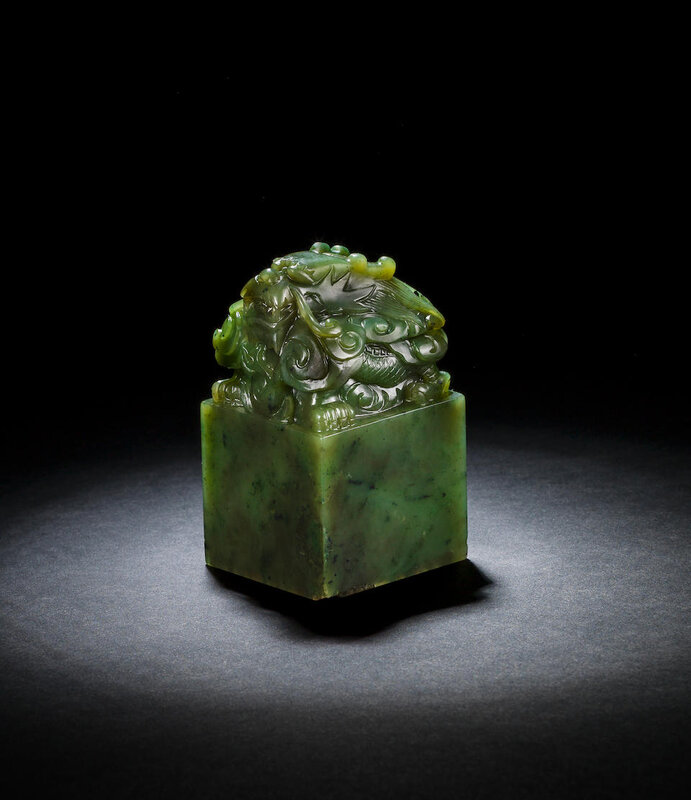
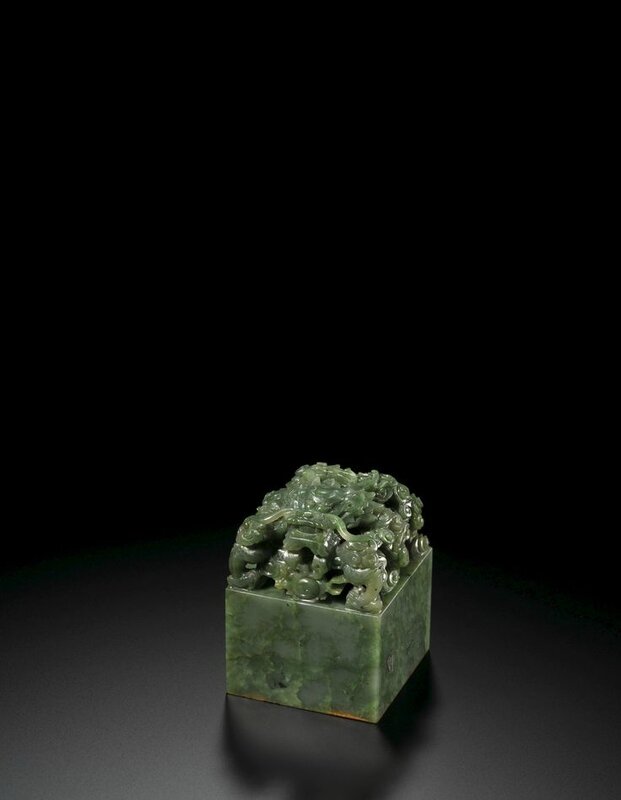
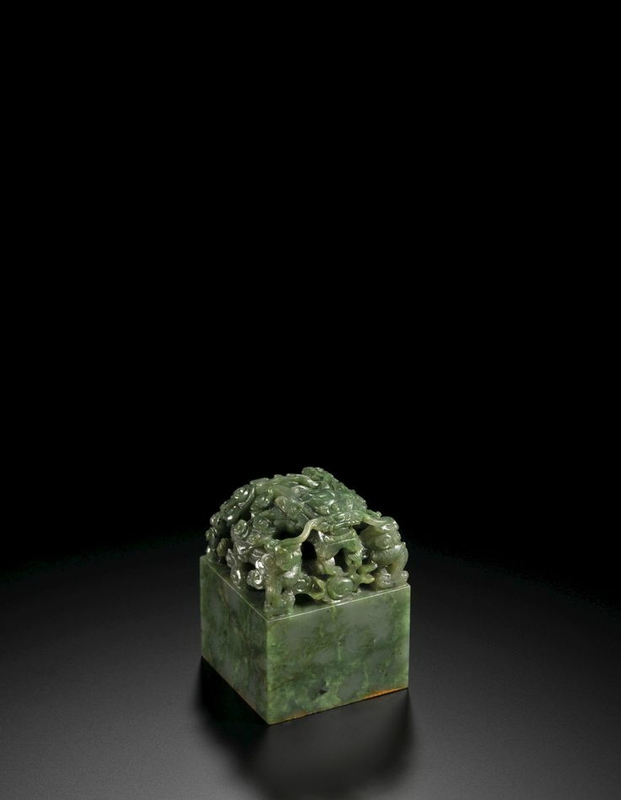






/image%2F1371349%2F20240416%2Fob_65a1d8_telechargement-31.jpg)
/image%2F1371349%2F20240331%2Fob_7209d9_117-1.jpg)
/image%2F1371349%2F20240324%2Fob_64049b_1.jpg)
/image%2F1371349%2F20240324%2Fob_a0994e_1.jpg)